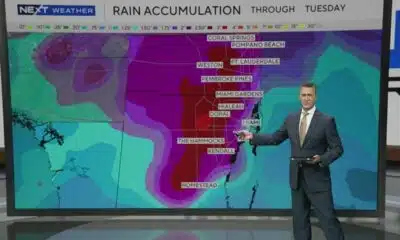News from the South - West Virginia News Feed
Cops, EMS, jail bills and more: How WV localities spent their first share of opioid settlement funds
by Caity Coyne, West Virginia Watch
July 22, 2025
More than half of the opioid settlement dollars spent by localities across West Virginia last fiscal year went to law enforcement, according to a West Virginia Watch analysis of a local spending report published by the West Virginia First Foundation last week.
According to the report, about $72.8 million in opioid settlement funds were disbursed to 226 local governments across the state. Of those local governments included in the report, 144 disclosed not spending any money. Sixteen other local governments did not return their spending reports to the First Foundation and are not included in this analysis.
The money disbursed to and spent by localities only accounts for the first opioid settlement allotment, covering the period between July 1, 2023 and June 30, 2024.
About 9.4% — more than $6.9 million — of the total $72.8 million received over that time was reported as being spent.
A majority of those funds — more than $3.64 million, or 52% — went to law enforcement. The second and third highest categories of spending were for quick response teams in the state, which received about $685,000, and first responders, which got about $643,000. That equates to 10% and 9% of all spending respectively.
Jail bills were the fourth highest expenditure for localities as nearly $520,000 was spent by counties paying them off.
Overall, the fifth highest spending category for the local settlement dollars was for treatment, rehab and recovery initiatives. About $444,200 was spent on these services, equating to about 6% of all money spent.
Read on below for more details on all of these spending categories and more in order of how much was allotted to them. Be sure to read the sidebar to this story for important caveats and information on both the spending report and West Virginia Watch’s analysis of it.
Law enforcement takes lion’s share of local dollars
Local governments spent more than five times as much on law enforcement and law enforcement-related investments than on any other expenditure, according to the spending reports.
Allocations to law enforcement totaled about $3.64 million of all the money spent last year. Nearly a quarter of that spending — about $888,000, or 24.4% — went toward purchasing new police vehicles.
In total, at least 22 vehicles were purchased for 12 different law enforcement agencies throughout the state. Most vehicles were purchased from local car dealers, according to the reports.
Some cars were purchased for new officers that were also hired by law enforcement agencies using settlement funds.
In total, about $817,000 was used by localities to cover salary increases for police officers, the creation of new roles in different types of response teams (i.e. a K-9 unit, a drug task force, etc.), existing police payroll, payroll taxes or new fiscal incentives and bonuses for officers.
At least three law enforcement agencies — St. Mary’s Police, Vienna Police Department and the Wirt County Sheriff’s Office — received funds to purchase dogs for new K-9 units. That spending totaled about $42,000, per the reports.
About $39,000 was spent by five local governments — Granville, Hinton, Lewisburg, Richwood and Oceana — on new firearms and ammo for police, according to the reports.
Communications, infrastructure and security upgrades — including new radios, mobile units, security cameras, drones, licensure for GIS mapping software and more — were the highest expenditure for law enforcement, totaling nearly $1.1 million.
About $177,000 of that spending came from Monroe County, where leaders put the money toward a new “jail reimbursement fund” which could also pay for overtime compensation and more for local officers in the future
The largest single line item expenditure for law enforcement came from the city of Princeton, which paid itself about $352,000 as “restitution for past expenditures on opioid abatement and law enforcement.”
While a total of $434,000 was spent on training for police officers, nearly all of that spending — about $430,400 — was by Jackson County to purchase land for a “Law Enforcement Training Center” and build a new shooting range for officers. Other training included about $2,600 in Fayetteville, where the city reimbursed itself for previous medical and first aid courses given to officers, and $750 in Paden City, where officers took a “street crime class.”
QRT and EMS investments combined total nearly 20% of all spending
Investments in quick response teams throughout the state totaled $685,000. Quick response teams are often a mix of law enforcement officials, counselors, peer coaches and first responders who contact individuals after an overdose occurs.
They work to ensure people are recovering from overdoses while building connections to help them get into rehab or meet other immediate needs that could be exacerbating their substance use disorder.
In Boone County, officials paid $25,000 for the county QRT to buy a new vehicle to help transport clients to treatment facilities. Charleston paid about $500,000 to cover salaries for two QRT positions that were previously covered by a grant that lapsed in 2023. The city also invested in hiring a mental health coordinator to help people facing mental health challenges navigate their options.
Cabell County and Jackson County gave $125,000 and $35,000 respectively to support their QRTs.
Spending for emergency medical services in the state focused largely on financial support for often under-funded and under-staffed volunteer fire departments as well as replacing outdated equipment and purchasing new tools to help first responders treat patients.
The Mingo County Commission spent a total of $275,000 giving $25,000 grants to 11 volunteer fire departments within the county.
Mullens, St. Albans and Oceana used some of their funds to buy new ambulances and fire trucks for county response teams. Several localities used a portion of their funds — totaling about $161,000 — for medical and training equipment for responders.
Three counties focus on oversized jail bills
Jail bills are charged to each county annually. The total amount charged depends on the number of incarcerated people from each locality that are being held in regional jails. In 2022, jail bills cost the state’s 55 counties a total of $45 million, with many local governments listing the charge as their largest annual expense.
Each county pays its jail bill at the same rate, but the totals differ depending on how many people from a county are being held at a regional jail. Until 2023, a cap was in place that limited the amount each county would be charged per an inmate at $48.25 per a day.
Without the cap, the cost for each person held in a regional jail is $54.48 per a day.
In 2023, when localities started to learn more about how much money they would receive through opioid settlements, concerns swirled that — due to how burdensome these jail bills are — many would put their allotments toward getting ahead on the recurring costs.
According to spending reports, three counties — Clay, Grant and Upshur — moved ahead with using their allocations for jail bills.
Clay County used its total 2024 allotment — about $229,550 — on the jail bill. Grant County spent $115,500 of its total $310,400 fund and Upshur County spent about $174,000 of its $348,000 on their jail bills. Those were the only expenditures made by all three counties last year.
Rehab, recovery and treatment see limited investments
Most of the money spent by localities on rehab, recovery and treatment efforts went as donations toward existing entities.
Cabell County had the largest expenditure for rehab, recovery and treatment, sending $200,000 to the nonprofit Lily’s Place for a program that provides housing to mothers and those expecting children as they go through recovery.
That investment accounted for 45% of all spending across the state on recovery and treatment efforts, per the reports.
The second largest expenditure for these categories came from Sistersville, where officials sent $85,000 to the New Beginnings Recovery Clinic so the organization could provide transport for patients receiving treatment.
Other nonprofits receiving funds for rehab, recovery and treatment include: $10,000 from Marion County to Compassion Central for the establishment of a recovery home, $27,600 from South Charleston to Pollen8 to help pay for administrative overhead and salaries and $10,000 from Ceredo to Recovery House of West Virginia for general program support.
Three day report centers in Hardy, Monroe and Pendleton counties received a combined total $82,000 from their county officials to go toward general program support.
GameChangers takes brunt of spending for youth services
More than half of the total $413,500 given by localities to programming for kids in West Virginia in fiscal year 2024 went to West Virginia GameChanger, a politically-connected program established in 2018 to teach prevention to kids in the classroom.
GameChanger received $270 million for programming from Marion County and $10,000 from Mason County. According to reporting from students at West Virginia University, other counties — Harrison, Jackson, Marshall and Mingo — also gave some of their opioid settlement funds to GameChangers.
Harrison and Marshall reported no spending for FY 2024. Mingo and Jackson did not list GameChangers as a recipient of funds. These counties could have used their second allotment of opioid dollars — given in January 2025 — for the expenditure.
GameChanger is based on school boards or individual schools paying a varying fee for prevention materials and a curriculum that experts have called questionable and based in fear, which are not conducive to lowering rates of drug use or overdose among students.
Behind GameChanger, the largest expenditure for youth services last year was given by the Hardy County Commission to Moorefield Athletic Boosters. According to the report, the $60,000 line item went toward repairs at Moorefield Middle School’s track. In the county report, officials said the repairs limited the risk of injuries on the field and that increased accessibility for the entire community could help build healthy habits instead that make substance use disorder less likely to develop.
Other child-focused kid programming from localities included: $10,500 for the June Harless Center’s Imagination Library, a childhood literacy program, from Hardy County ($5,000), Moorefield ($5,000) and Wardensville ($500); $10,000 by Oceana to put on a “Say No To Drugs” show as well as a “drug awareness special needs fishing tournament”; $10,000 from Bluefield for purchase of land to create a youth summer camp and numerous small donations to local nonprofit organizations.
Local governments use settlement funds to keep afloat
The outlined uses for opioid settlement funds are, generally, broad. In West Virginia, where several local governments run on shoe-string budgets, two localities — Oceana, in Wyoming County, and Williamson, in Mingo County — opted to use portions of their settlement funds to keep operations afloat.
In Williamson, officials transferred about $133,200 from its opioid settlement to the city’s general fund to “pay bills and make payroll.” It’s unclear if those funds were paid back and officials with the city could not be reached for comment. Williamson reported spending a total of $173,230 of its settlement fund last year, however no explanation was given on the report for the remaining $40,000.
In Oceana, the town reported three transactions — one for $8,000, another for about $26,300 and a final one for $32,200, totalling nearly $66,500 — transferring money from the opioid settlement fund to the town’s general fund. The money, according to the report, “covered a temporary shortage for the town.”
The first two transfers, per the spending explanation, were paid back following the end of FY2024. The $32,200 transfer is in the process of being repaid. Another $4,120 transfer was made, however according to the report it was accidentally transferred and has also been paid back.
Bank fees, nonprofit donations, infrastructure and more
A mix of uncategorized or small payments make up this final category, which totalled $205,200 accounting for a mix of bank fees, infrastructure projects, nonprofit donations, unaccounted spending and more.
Fourteen localities spent a combined total of nearly $1,400 on bank fees for opening the opioid accounts as well as ordering checks to disburse funds.
Mineral County gave $6,000 to its Family Resource Network for funding its portion of a federal Substance Abuse and Mental Health Services grant. The program, per the spending explanation, will help with substance abuse prevention service across the community. Given cuts and changes at the federal level, however, it’s unclear how long the federal program will exist to help offer such services.
Other general support donations included: $57,000 from Logan County to the Marjorey Oakley Home For Women, $25,000 from South Charleston to Heart and Hand Outreach Ministries for the hiring of a social worker and $10,000 from Marion County to the North Marion Talking About Consumption of Substances Program.
In total, $133,716.68 of funds that local governments reported as spending were unexplained in the report and, therefore, considered unaccounted for at this time.
West Virginia Watch is part of States Newsroom, a nonprofit news network supported by grants and a coalition of donors as a 501c(3) public charity. West Virginia Watch maintains editorial independence. Contact Editor Leann Ray for questions: info@westvirginiawatch.com.
The post Cops, EMS, jail bills and more: How WV localities spent their first share of opioid settlement funds appeared first on westvirginiawatch.com
Note: The following A.I. based commentary is not part of the original article, reproduced above, but is offered in the hopes that it will promote greater media literacy and critical thinking, by making any potential bias more visible to the reader –Staff Editor.
Political Bias Rating: Center-Left
This content takes a detailed, investigative approach to the allocation of opioid settlement funds in West Virginia, emphasizing the substantial share directed toward law enforcement and the comparatively smaller investments in treatment and recovery. The focus on scrutinizing law enforcement spending, highlighting funds used for police vehicles and jail bills, and mentioning a “politically-connected program” with a critical tone toward prevention efforts suggests a perspective inclined toward questioning the prioritization of punitive measures over public health approaches. While it remains factual and data-driven, the critique of law enforcement priorities and the call for more recovery-focused funding aligns with Center-Left values emphasizing social services and reform over strict law-and-order spending.
News from the South - West Virginia News Feed
WV Supreme Court will hear BOE’s appeal in vaccine lawsuit — but not right away
by Lori Kersey, West Virginia Watch
September 5, 2025
West Virginia’s highest court will take on a legal battle over the state’s school vaccination requirements, but it denied a request by state school officials that it do so quickly.
The state Supreme Court on Thursday set a deadline of Dec. 12 for the West Virginia Board of Education to prepare its appeal of a Raleigh County judge’s July ruling against it. That ruling was in regards to a lawsuit brought by three Raleigh County families over the board’s refusal to accept religious exemptions to the state’s mandatory school vaccine requirements.
Raleigh County Circuit Judge Michael Froble in July granted a preliminary injunction in the case that allows students in the case to attend class with a religious exemption to the vaccination requirements.
The school board had filed notice of appeal and asked the high court to both expedite a review of the appeal and temporarily halt the proceedings in the lower court.
In the scheduling order Thursday, the court denied both motions. Justices also set a deadline of Jan. 26 for the plaintiffs in the case to respond to the board’s appeal. The board will then have until Feb. 16, 2026 to write a reply, if necessary.
After the Feb. 16 reply brief deadline, the court writes, the appeal will be ready for review.
The Raleigh lawsuit is one case in a legal battle over religious freedom and the state’s strict school vaccination requirements. Every state requires school students to be vaccinated against a number of infectious diseases including polio, chicken pox and measles. Florida officials announced this week plans to eliminate its vaccine mandates.
West Virginia has been one of only five states that have not allowed students to opt out of the shots because of their religious or philosophical objections to them.
West Virginia Gov. Patrick Morrisey issued an executive order on his second day in office requiring the state to allow religious exemptions. His order is based on the 2023 Equal Protection for Religion Act. He argues that the religious freedom law, when read alongside the vaccination law, calls for the religious exemptions.
Morrisey has not rescinded that executive order, even though the state Legislature earlier this year rejected a bill that would have established those religious exemptions in state code.
Raleigh County Circuit Judge Michael Froble has scheduled a two-day hearing next week on a permanent injunction in the lawsuit, which he recently consolidated with a lawsuit brought against the state health department by two parents of immunocompromised students over its issuance of religious exemptions. Plaintiffs in that case are represented by the ACLU of West Virginia and Mountain State Justice.
The hearing is set for Sept. 10 and 11 at the Raleigh County Judicial Center. During that hearing, the judge has said he wants to consider issues that include whether the state’s vaccination law is constitutional without religious exemptions and the authority of Morrisey’s executive order.
YOU MAKE OUR WORK POSSIBLE.
West Virginia Watch is part of States Newsroom, a nonprofit news network supported by grants and a coalition of donors as a 501c(3) public charity. West Virginia Watch maintains editorial independence. Contact Editor Leann Ray for questions: info@westvirginiawatch.com.
The post WV Supreme Court will hear BOE’s appeal in vaccine lawsuit — but not right away appeared first on westvirginiawatch.com
Note: The following A.I. based commentary is not part of the original article, reproduced above, but is offered in the hopes that it will promote greater media literacy and critical thinking, by making any potential bias more visible to the reader –Staff Editor.
Political Bias Rating: Centrist
The content presents a factual and balanced overview of the legal dispute surrounding vaccine exemptions in West Virginia without evident partisan language or framing. It reports on actions taken by government officials, court decisions, and ongoing lawsuits from multiple perspectives, including those of the state board, families, and advocacy groups. The neutral tone and focus on legal developments suggest a centrist approach, aiming to inform rather than persuade toward a particular political viewpoint.
News from the South - West Virginia News Feed
Christian’s Morning Forecast: Strong to Severe Storms Incoming
SUMMARY: Storm Watch meteorologist Christian Boler reports strong to severe storms approaching West Virginia, especially McDow, Tazewell, and Wyoming counties during the morning commute. Temperatures will remain in the upper 60s to low 70s with southwest winds around 5-10 mph. A marginal severe weather threat exists across the region, mainly involving winds and flooding, but no tornadoes or hail expected. Rainfall of a quarter to half an inch is likely over 48 hours with isolated downpours. Storms will arrive in two waves before clearing Friday. Another front may bring showers Saturday, but high pressure will clear skies for the weekend and beyond.
FOLLOW US ON FACEBOOK AND TWITTER:
https://facebook.com/WOAYNewsWatch
https://twitter.com/WOAYNewsWatch
News from the South - West Virginia News Feed
More states guarantee students the right to school-day religious instruction off campus
by Robbie Sequeira, West Virginia Watch
September 4, 2025
In the past month or so, federal courts have dealt a string of blows to conservatives’ push for the biblical Ten Commandments to be posted in public schools.
Yet as states lose over required religious displays, many are working on another route to faith-based education by allowing kids to attend off-campus religious instruction. This year, Iowa, Montana, Ohio and Texas passed laws guaranteeing parents the right to have their children excused during the school day for free, off-campus religious instruction, often called “released time.”
Those four states are the latest of at least 12 that require school districts to offer released time religious schooling upon parental request, including: Florida, Hawaii, Kentucky, New York, North Dakota, Pennsylvania, Vermont and Wisconsin.
The released time approach may be more likely to pass constitutional muster than other government-imposed religious efforts, experts say, by shifting influence off school grounds and under the direction of faith-based groups rather than public school teachers, and by making it free to students.
A 1952 U.S. Supreme Court decision in Zorach v. Clauson allows for released time religious instruction as long as it’s off school property, privately funded and parent permitted.
“Not every family has access to private or parochial school, but for many generations families have been able to take their students out of school for a portion of the day for religious education if they choose,” said Jennifer Jury, a program advocate for LifeWise Academy, an Ohio-based Christian nonprofit founded in 2018.
The organization has been active in expanding its reach and lobbying lawmakers for stronger legislative support. This school year, LifeWise expects to serve nearly 100,000 public school students across 1,100 schools in 34 states, Jury said.
The off-campus gatherings work the same way in most states: With parents’ approval, public school students sign out of school during a lunch, recess or study hall block. Students will either walk or ride one of the distinctive red LifeWise buses to a local church or a program-leased community building in town.
And depending on state limitations for the religious instruction, for either a half or full hour, kids will learn about the Bible. When the allotted time is up, students go back to their public school to finish the day.
In some states, students can earn academic credit for the off-campus instruction, which has been more controversial.
In Montana, for example, legislation that would have required school districts to develop policies for academic credit was amended to “authorize” a district to allow credit, after pushback from the state’s school boards and school administrators associations.
“School districts should have the autonomy to determine which external coursework aligns with the academic frameworks and whether such courses should be eligible for credit,” Rob Watson, who represented the two groups at the legislature, said in his comments to a House committee in February. He noted the groups did not oppose the released time policy itself.
Despite the changes, only one Democrat in the legislature voted “yes.” Montana GOP Gov. Greg Gianforte signed the bill into law in May.
Supporters had touted the academic credit option as a way to entice homeschooling families to consider public schools. In her interview with Stateline, Jury noted similar programs that accommodate Jewish, Muslim and Mormon faith-based teaching for public school students.
“Whether a person is religious or not, the Bible is widely recognized as one of the most influential books in history,” Jury said. “A lot of our Western culture was born out of ideas that come from the Bible, like the fact that every person is created equal, that we are to love our neighbor.”
Identical bill language
The conservative American Legislative Exchange Council, known as ALEC, in August adopted model legislation about released time policies that state lawmakers can propose.
Public schools would be required to allow dismissal for religious instruction under new bill
ALEC’s proposal would allow from one to five hours per week of off-campus religious instruction and would require school districts to award academic credit if the course meets certain criteria. Districts would have to assess instruction based on secular standards and would not be allowed to test for particular religious content, according to the model legislation.
Nearly identical language had already appeared in several state bills, including in North Carolina and West Virginia this year and in Mississippi in 2023. In North Carolina, LifeWise Academy registered with the secretary of state’s office in 2024, as reported by NC Newsline, and a released time bill was introduced in February. It was sent to committee but never moved ahead.
The bills in Mississippi and West Virginia also stalled.
Legislation that does become law earns praise from groups such as Alliance Defending Freedom, one of the nation’s most active legal organizations opposing abortion rights and same-sex marriage.
Statements from Greg Chafuen, senior counsel for the nonprofit’s Center for Public Policy, say the new released time laws respect “parents’ educational decisions” and ensure “parents are in the driver’s seat when it comes to their kids’ education.”
An Indiana law lets high school students leave school for religious instruction each week for an amount of time equal to one elective course. Ohio, Oklahoma, South Carolina and Tennessee laws allow students to earn elective credit for released time religious instruction, though it cannot replace a “core curriculum” class. School boards can set standards for when such programs qualify for credit.
LifeWise operates in each of those states.
Ten Commandment displays
Jury, of LifeWise Academy, said her organization wants off-campus religious options for public school students to be available in all 50 states.
“It’s important to note this is an option, and parents are the ultimate decision-makers in enrollment,” she said.
“We would love to see every student in the United States have the option to attend a program like LifeWise if they want to and if their parents want them to.”
A lack of parental choice might be what trips up state efforts to post the Ten Commandments in classrooms.
This is an option, and parents are the ultimate decision-makers in enrollment.
– Jennifer Jury, a program advocate for LifeWise Academy
After Louisiana last year became the first state in recent decades to require that the Ten Commandments, a central tenet of the Judeo-Christian tradition, be displayed in school classrooms, bills followed in at least 15 other states. Two states — Arkansas and Texas — enacted laws.
But for now, courts have blocked the mandates in all three states. In Texas, U.S. District Judge Fred Biery warned the displays “are likely to pressure [children] into religious observance” and undermine parents’ rights.
In Arkansas, U.S. District Judge Timothy Brooks called the state’s requirement to post a specific version of the Ten Commandments “plainly unconstitutional.”
The law “is not neutral with respect to religion,” he wrote. “By design, and on its face, the statute mandates the display of expressly religious scripture in every public-school classroom and library.”
He also noted that the law “requires that a specific version of that scripture be used, one that the uncontroverted evidence in this case shows is associated with Protestantism and is exclusionary of other faiths.”
Stateline reporter Robbie Sequeira can be reached at rsequeira@stateline.org.
This story was originally produced by Stateline, which is part of States Newsroom, a nonprofit news network which includes West Virginia Watch, and is supported by grants and a coalition of donors as a 501c(3) public charity.
West Virginia Watch is part of States Newsroom, a nonprofit news network supported by grants and a coalition of donors as a 501c(3) public charity. West Virginia Watch maintains editorial independence. Contact Editor Leann Ray for questions: info@westvirginiawatch.com.
The post More states guarantee students the right to school-day religious instruction off campus appeared first on westvirginiawatch.com
Note: The following A.I. based commentary is not part of the original article, reproduced above, but is offered in the hopes that it will promote greater media literacy and critical thinking, by making any potential bias more visible to the reader –Staff Editor.
Political Bias Rating: Center-Right
This content presents the growing trend of religious education programs in public school contexts with a generally favorable tone, highlighting legislative successes primarily in conservative-led states. The coverage includes references to conservative organizations such as ALEC and Alliance Defending Freedom, and discusses efforts to expand religious instruction in a way that aligns with conservative values emphasizing parental choice and the role of faith in education. However, it also acknowledges the legal challenges and concerns over constitutional boundaries, providing a balanced view that avoids outright advocacy or criticism. The framing and topics suggest a center-right perspective that supports religious accommodations within public education while respecting legal constraints.
-
Mississippi Today7 days ago
DEI, campus culture wars spark early battle between likely GOP rivals for governor in Mississippi
-
News from the South - Louisiana News Feed6 days ago
‘They broke us down’: New Orleans teachers, fired after Katrina, reflect on lives upended
-
News from the South - Alabama News Feed7 days ago
Alabama state grocery tax to fall 1% on Monday
-
News from the South - Missouri News Feed5 days ago
Missouri joins dozens of states in eliminating ‘luxury’ tax on diapers, period products
-
News from the South - Tennessee News Feed5 days ago
Tennessee ranks near the top for ICE arrests
-
Mississippi Today5 days ago
Trump proposed getting rid of FEMA, but his review council seems focused on reforming the agency
-
News from the South - South Carolina News Feed7 days ago
Warm and Mainly Dry Labor Day
-
News from the South - North Carolina News Feed6 days ago
NC Labor Day 2025: A state that’s best for business is also ranked worst for workers










































